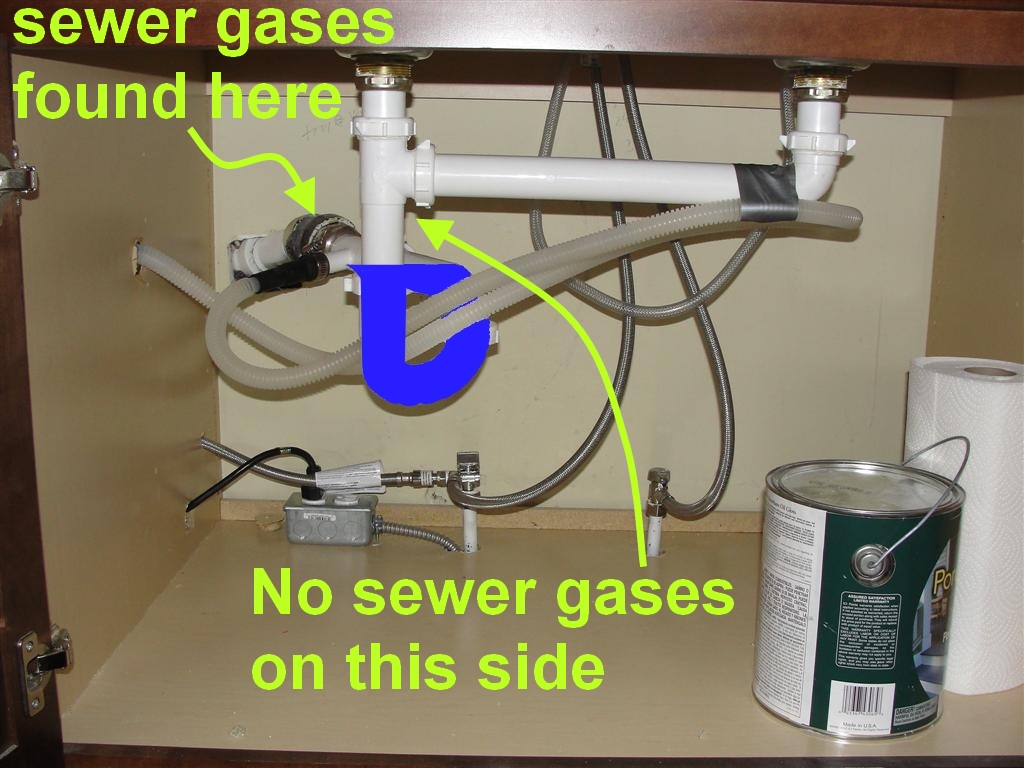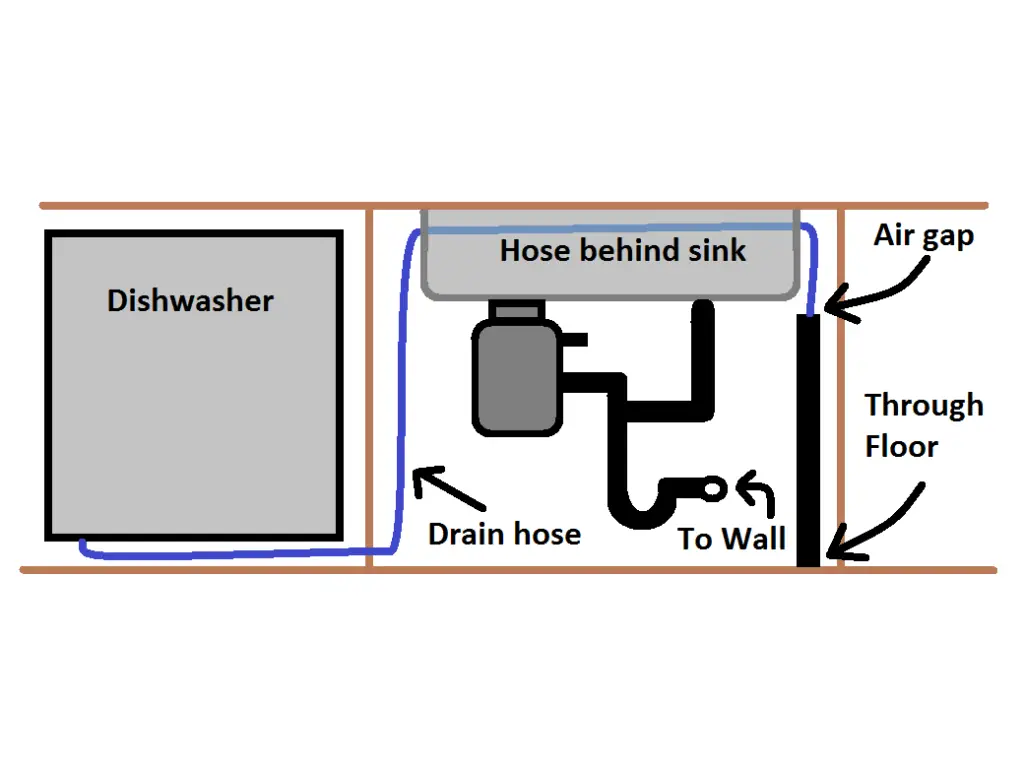To hook up a dishwasher to a garbage disposal, connect the dishwasher drain hose to the disposal unit’s inlet. Ensure a high loop or air gap to prevent backflow.
Connecting a dishwasher to a garbage disposal streamlines kitchen cleanup and saves space. This connection allows waste water and food particles from the dishwasher to flow directly into the disposal system. A proper hookup requires basic plumbing knowledge and compliance with local building codes.
A high loop or air gap installation is crucial to keep the dishwasher running efficiently and to prevent sink water from backing up into the dishwasher. Setting up this system can be a DIY project for those familiar with household tools and plumbing or a quick job for a professional. It’s an effective integration that optimizes kitchen waste management and the functionality of both appliances.
Introduction To Dishwasher And Garbage Disposal Connections
Understanding how to connect a dishwasher to a garbage disposal simplifies kitchen chores. This integration enhances efficiency and cleanliness. It is essential for modern homes. Let’s explore how these appliances work together.
Benefits Of Integrating Dishwasher With Garbage Disposal
- Effective waste management: Food particles from dishes get ground up by the disposal.
- Better drainage: The disposal helps prevent clogs in your kitchen pipes.
- Simplified plumbing: One connection to the sewage system is more straightforward than separate lines.
- Hygienic solution: Immediate disposal of food waste reduces odor and bacteria growth.
- Energy efficiency: Running a single system uses less water and electricity
Basic Principles Of A Dishwasher To Garbage Disposal Hookup
- Power off both units before starting.
- Ensure a high loop in the dishwasher drain hose to prevent backflow.
- Connect the dishwasher drain hose to the disposal inlet.
- Use a clamp to secure the hose and prevent leaks.
- Check for proper installation by running both appliances through a cycle.
Required Tools And Materials
Embarking on a dishwasher hookup to your garbage disposal is straightforward with the right tools and materials. A successful installation ensures a seamless kitchen cleanup routine. Let’s dive into the necessary items you’ll need to complete this task efficiently and effectively.List of Necessary Tools
List Of Necessary Tools
Equipping yourself with the correct tools is the first step. A well-prepared toolbox is essential for a smooth installation. Take a look at this list of tools you’ll need:
- Screwdrivers (both flat-head and Phillips)
- Adjustable wrench
- Wire strippers
- Plumber’s putty or silicone caulk
- Utility knife
- Hose clamps for securing connections
Selection of Appropriate Materials and Parts
Selection Of Appropriate Materials And Parts
Selecting the right materials ensures durability and compliance with standard plumbing practices. Use these preferred materials and parts for a leak-free installation:
| Material/Part | Use |
|---|---|
| Dishwasher drain hose | Connects dishwasher to the garbage disposal |
| Hose clamp | Secures the drain hose to the disposal unit |
| Wire nuts | For safe electrical connections |
| Electrical tape | Insulates wire connections |
| Disposal drain connector | Attachment point for the dishwasher hose |
By gathering these tools and materials before you start, you’re setting the stage for a hassle-free installation.
Safety Precautions Before Starting
Before diving into the world of DIY dishwasher and garbage disposal hookups, safety comes first. The risk of electrical shock or a water leak is real. Knowing the right safety measures can prevent injury and damage. Here are the crucial steps to follow.
Electrical Safety Measures
Turn off the power at the circuit breaker before starting. Use a voltage tester to ensure no current flows through the wires you will touch. Securing electrical safety shields you from hazards.
- Check for signs of frayed wires or damage
- Wear rubber-soled shoes for insulation
- Avoid working in wet conditions
Plumbing Safety Tips
Plumbing involves water and sometimes heavy gear. To prevent water damage or personal injury, heed these tips:
- Close the water supply to avoid flooding.
- Inspect all hoses and connections for wear or damage.
- Keep tools and materials organized to avoid mishaps.
- Use gloves to protect from sharp edges and hot pipes.
With these safety measures in place, you’re set to start your project!

Credit: m.youtube.com
Step-by-step Hookup Process
Are you ready to integrate your dishwasher with your garbage disposal? It’s simpler than you think! Let’s dive into the step-by-step hookup process. This guide ensures you can complete the task efficiently and safely. Follow along for a seamless installation!
Disconnecting Power And Removing Sink Plug
Before starting, safety comes first. Always disconnect power to your dishwasher and garbage disposal. Flip the circuit breaker or unplug them. With no power, it’s safe to proceed. Underneath your sink, locate the garbage disposal. Find the round, metal sink plug. You need to remove it to allow water to pass from the dishwasher to the disposal. A few firm taps with a screwdriver and hammer should pop it free. Remember to remove the loose plug from inside the disposal unit to avoid blockages.
Attaching The Drain Hose To The Garbage Disposal
Next, grab your dishwasher’s drain hose. It’s usually a flexible, corrugated tube. Line up the drain hose end with the disposal’s inlet nozzle. Usually, it’s a stubbed pipe protruding from the disposal. You may need to trim the hose for a snug fit. Once aligned, slide the hose securely onto the nozzle. Use a hose clamp to ensure it stays in place. Tighten the clamp with a screwdriver for a firm hold.
Ensuring Secure And Leak-proof Connections
Last, inspect all connections for potential leaks. Check the drain hose and clamp for tightness. The disposal unit should sit flush with the sink drain. Run some water through the disposal to test the connection. No drips or moisture should be present. If you discover a leak, re-tighten clamps and ensure all parts fit correctly. Doing this right the first time prevents future issues.
Troubleshooting Common Issues
Welcome to the “Troubleshooting Common Issues” section of our guide on dishwasher hookup to garbage disposal. Even with the right setup, problems can arise. Let’s tackle these head-on to keep your kitchen running smoothly.
Dealing With Leaks And Clogs
If your dishwasher and disposal are wet friends, you may find unwanted puddles or blockages. Follow these steps to fix them:
- Check the hose: Ensure connections between your dishwasher and disposal are tight.
- Inspect for wear and tear: Old hoses can crack, necessitating a swift replacement.
- Clear the clogs: If your disposal is slow or stopped, unclog it to prevent backflow into your dishwasher. Always disconnect power first!
Electrical Connection Problems
When dishes stay dirty, and the disposal won’t buzz, electrical woes might be afoot. Implement these solutions:
- Power status: Ensure both your dishwasher and disposal have power.
- Check connections: Loose wires can cause interruptions. Tighten them up but switch off the power first.
- Reset your disposal: Hit the reset button on the unit. It might just do the trick.
If these tips don’t solve the issue, a professional might need to step in.

Credit: structuretech.com
Maintenance And Upkeep
Keeping your dishwasher and garbage disposal in harmony is key to a smooth-running kitchen. Like any well-oiled machine, they require regular maintenance. We’re diving into the best practices for keeping your system clean and functioning. Let’s talk about how simple upkeep can prevent major issues, ensuring your dishwasher and disposal work together seamlessly.
Routine Cleaning For Optimal Performance
Regular cleaning is vital for efficiency. It avoids build-ups that can clog or damage your system. Here’s your go-to guide:
- Weekly, run your garbage disposal with cold water and mild soap.
- Clean your dishwasher filter monthly to remove food particles.
- Use a dishwasher cleaning agent every six months for a deeper cleanse.
Vinegar and baking soda are your friends. Run a cycle with this pair to deodorize and clear out residue.
Don’t ignore bad smells or slow drainage. Act fast to clear out blockages. Your dishwasher and garbage disposal will thank you.
When To Seek Professional Help
Some issues are best left to the pros. If you notice any of the following, it’s time to call in expert help:
- Persistent bad odors despite routine cleaning.
- Water backing up into the dishwasher.
- Strange noises from your disposal unit.
- Visible leaks or damage to hose connections.
DIY solutions are great, but professional assessments ensure long-term fixes. Save yourself from future headaches and get expert advice when these signs appear.
:max_bytes(150000):strip_icc()/garbage-disposal-installation-1824830-hero-1dcd7b5b05d44a2cb367e31692500c8c.jpg)
Credit: www.thespruce.com
FAQs For Dishwasher Hookup To Garbage Disposal
Can I Connect Dishwasher To Garbage Disposal?
Yes, you can connect a dishwasher to a garbage disposal. Ensure you follow the disposal unit’s installation instructions for proper setup.
Can You Put A Garbage Disposal And Dishwasher On The Same Circuit?
Yes, a garbage disposal and dishwasher can share a circuit if the total load doesn’t exceed the circuit’s capacity, typically 15 to 20 amps. Always consult local codes and an electrician for safety.
Can Garbage Disposal Keep Dishwasher From Draining?
Yes, a clogged garbage disposal can prevent a dishwasher from draining properly if they are connected.
How Do You Plug A Dishwasher Hole In A Garbage Disposal?
To plug a dishwasher hole in a garbage disposal, insert a plug or cap designed for this purpose into the hole. Ensure it fits snugly and secure it following the manufacturer’s instructions. This prevents leaks and keeps the disposal system working efficiently.
Conclusion
Connecting a dishwasher to a garbage disposal simplifies kitchen cleanup and increases efficiency. Ensure a seamless installation by following proper guidelines or seeking professional help. Keep safety top of mind when dealing with plumbing and electrical components. With your dishwasher now adeptly hooked up to the garbage disposal, enjoy the convenience and ease it brings to your daily routine.

